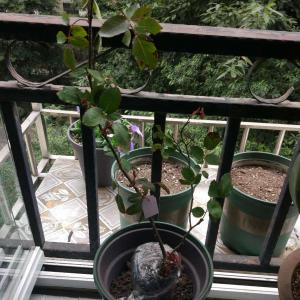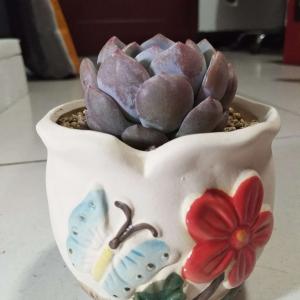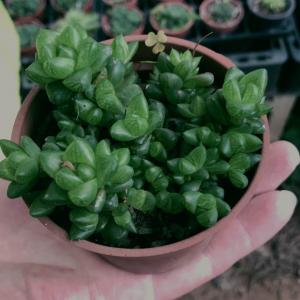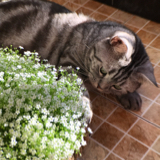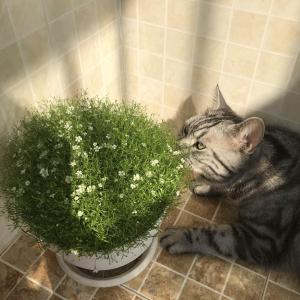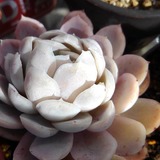文章
Miss Chen
2018年03月19日

Description: This annual or biennial wildflower develops ascending to sprawling stems about 1½–3' long. The stems are light green to reddish green and pubescent with short spreading hairs. Either opposite or alternate leaves occur at intervals along the stems; the leaf blades are up to 3" long and 3" across and deeply cleft into 3-5 palmate lobes. The leaf margins are sparingly dentate or further divided into small secondary lobes. The upper leaf surfaces are medium green and hairless (or sparingly so), while the their lower surfaces are pale green and pubescent. The petioles are light green and pubescent. At the base of each petiole, there is a pair of small linear stipules. From the axils of the middle to upper leaves, clusters of 2 or more flowers develop on slender pubescent stalks; these stalks are about ¾–1½" long at maturity.
Each flower is about 1/3" (8 mm.) across, consisting of 5 light pink petals, 5 green sepals, 10 stamens, and a pistil. Fine pink lines radiate from the throat of each flower. The petals are oblong in shape and slightly notched at their tips. The sepals are lanceolate to ovate and pubescent; each sepal has an awn-like tip about 1.5 mm. long. The blooming period occurs during the summer and lasts about 2 months. Usually, only a few flowers are in bloom at the same time. Each flower is replaced by a narrow columnar fruit about ½–¾" long that tapers to a short beak. At maturity, the fruit splits open into 5 slender sections from the bottom, remaining connected together at the apex. By this process, the seeds are mechanically ejected from the mother plant.
Cultivation: The preference is partial sun, mesic to dry-mesic conditions, and cool to warm summer temperatures. Different kinds of soil are tolerated, including those that are sandy or rocky.
Range & Habitat: Northern Cranesbill is restricted to NE Illinois, where it is rare and native to the area (see Distribution Map). This species is state-listed as 'endangered.' Illinois lies at the southern range-limit of this boreal wildflower. Habitats include woodland openings, sandy Black Oak woodlands, typical and sandy savannas, and rocky outcrops. This wildflower becomes more abundant after a wildfire; there is some evidence that its seeds germinate in response to heat and/or light.

Faunal Associations: The flowers are pollinated by small flies (particularly Syrphid flies) and small bees (particularly Halictid bees). Both nectar and pollen are available as floral rewards to such visitors. One insect that sucks on the juices of Geranium spp. is Macrosiphum geranii (Geranium Aphid). The seeds of some Geranium spp. are eaten by such birds as the Mourning Dove and Bobwhite Quail to a limited extent.
Photographic Location: A nature preserve in Cook County, Illinois. The photographs were taken by Lisa Culp (Copyright © 2009).
Comments: This is one of several annual or biennial Geraniums (Geranium spp.) in Illinois. The majority of these species have been introduced from Eurasia, although some of them are native. All of these species have relatively small flowers, palmately cleft simple leaves (see exception below), and a sprawling to ascending habit. As a result, they can be difficult to distinguish from each other. Northern Cranesbill can be identified through the following combination of characteristics: 1) It produces small flowers (about 1/3" across) in clusters of 2 or more, 2) the stems and stalks of the flowers are pubescent with short spreading hairs, 3) the pedicels of the flowers/fruits are longer than the sepals, and 4) the sepals have awn-like tips. One aberrant species in this group, Herb Robert (Geranium robertianum), differs from the others by its leaves, which are palmately divided into leaflets with petioles.
Each flower is about 1/3" (8 mm.) across, consisting of 5 light pink petals, 5 green sepals, 10 stamens, and a pistil. Fine pink lines radiate from the throat of each flower. The petals are oblong in shape and slightly notched at their tips. The sepals are lanceolate to ovate and pubescent; each sepal has an awn-like tip about 1.5 mm. long. The blooming period occurs during the summer and lasts about 2 months. Usually, only a few flowers are in bloom at the same time. Each flower is replaced by a narrow columnar fruit about ½–¾" long that tapers to a short beak. At maturity, the fruit splits open into 5 slender sections from the bottom, remaining connected together at the apex. By this process, the seeds are mechanically ejected from the mother plant.
Cultivation: The preference is partial sun, mesic to dry-mesic conditions, and cool to warm summer temperatures. Different kinds of soil are tolerated, including those that are sandy or rocky.
Range & Habitat: Northern Cranesbill is restricted to NE Illinois, where it is rare and native to the area (see Distribution Map). This species is state-listed as 'endangered.' Illinois lies at the southern range-limit of this boreal wildflower. Habitats include woodland openings, sandy Black Oak woodlands, typical and sandy savannas, and rocky outcrops. This wildflower becomes more abundant after a wildfire; there is some evidence that its seeds germinate in response to heat and/or light.

Faunal Associations: The flowers are pollinated by small flies (particularly Syrphid flies) and small bees (particularly Halictid bees). Both nectar and pollen are available as floral rewards to such visitors. One insect that sucks on the juices of Geranium spp. is Macrosiphum geranii (Geranium Aphid). The seeds of some Geranium spp. are eaten by such birds as the Mourning Dove and Bobwhite Quail to a limited extent.
Photographic Location: A nature preserve in Cook County, Illinois. The photographs were taken by Lisa Culp (Copyright © 2009).
Comments: This is one of several annual or biennial Geraniums (Geranium spp.) in Illinois. The majority of these species have been introduced from Eurasia, although some of them are native. All of these species have relatively small flowers, palmately cleft simple leaves (see exception below), and a sprawling to ascending habit. As a result, they can be difficult to distinguish from each other. Northern Cranesbill can be identified through the following combination of characteristics: 1) It produces small flowers (about 1/3" across) in clusters of 2 or more, 2) the stems and stalks of the flowers are pubescent with short spreading hairs, 3) the pedicels of the flowers/fruits are longer than the sepals, and 4) the sepals have awn-like tips. One aberrant species in this group, Herb Robert (Geranium robertianum), differs from the others by its leaves, which are palmately divided into leaflets with petioles.
0
0
文章
Miss Chen
2018年03月19日

Description: This low deciduous shrub is 1-3' tall, branching occasionally. Young stems are yellowish green to reddish brown, pubescent or hairless, while older stems are light gray to nearly black. The wood of the stems is relatively brittle and weak. The blades of alternate leaves are 1-2¼" long and ½-1" across; they are oblong-ovate, obovate, or narrowly oval and smooth along their margins. The upper surface of the blades is yellowish green and slightly shiny, while the lower surface is dull yellowish green and more or less covered with fine resinous dots that are yellow (more visible with a 10x hand lens). The petiole is short and slender. Short fine hairs are often present on the lower blade surface and petioles. The flowers develop in raceme-like clusters from the axils of the leaves. Individual flowers are up to 1/3" (8 mm.) long and a little less across, consisting of a short yellowish green calyx with 5 broad lobes and a tubular corolla with 5 tiny lobes along its rim that are strongly recurved. The red corolla (rarely white) is slightly constricted toward its throat, forming an urn-like shape. Each flower also has 10 inserted stamens and a pistil with a single style. The pedicels and calyces of the flowers are covered with short fine hairs and/or yellow resinous dots. The blooming period occurs from late spring to early summer, lasting about 3 weeks. Later, the flowers are replaced by globoid berries up to 1/3" (8 mm.) across. These berries are initially green, but they become blue-black at maturity. The interior of each berry is fleshy and sweet; it contains 10 seeds, which are individually up to 2 mm. long. The woody root system is shallow and branching; it can develop clonal offsets from underground runners. Colonies of plants are often produced. The leaves turn red during the autumn before falling to the ground.
Cultivation: The preference is partial sun, mesic to dry conditions, and an acidic soil that is sandy or rocky. Plants that are grown in too much shade may fail to produce flowers and fruit. The flowers are self-fertile, but fruit production is better when there is cross-pollination.
Range & Habitat: Black Huckleberry is a native shrub that is found primarily in northern and southern Illinois (see Distribution Map), where it is occasional in sandy or rocky areas. Elsewhere in the state, it is rare or absent. Habitats consist of upland rocky woodlands, wooded slopes, sandy savannas, openings in sandy woodlands, sandy shrub prairies, rocky bluffs and sandstone cliffs, sandy or rocky thickets, and stabilized sand dunes. Outside of Illinois, this shrub is sometimes found in bogs. Because it is able to resprout from underground runners, this shrub adapts to fire-prone habitats. In sandy shrub prairies, it is occasionally the dominant plant.

Faunal Associations: The flowers are cross-pollinated primarily by honeybees, bumblebees, and Andrenid bees. Other floral visitors include the Karner Blue butterfly and various Syrphid flies. These insects seek primarily nectar from the flowers, although the Syrphid flies probably feed on the pollen. The caterpillars of the butterfly Callophrys henrici (Henry's Elfin) feed on Black Huckleberry, as do the caterpillars of several moths, specifically: Amorbia humerosana (White-Lined Leafroller), Chrysanympha formosa (Formosa Looper Moth), Croesia curvalana (Blueberry Leaftier), Cyclophora pendulinaria (Sweet Fern Geometer), Melanomma auricinctaria (Gold-Lined Melanomma), Pangrapta decoralis (Decorated Owlet), Psectraglaea carnosa (Pink Sallow), Sphinx gordius (Gordian Sphinx), Synchlora aerata (Wavy-Lined Emerald), and Zomaria interruptolineana (Broken-Lined Zomaria). Another insect that feeds on Black Huckleberry is Melanoplus fasciatus (Huckleberry Spur-Throated Grasshopper).

Among vertebrate animals, the fruit is eaten by many species of upland gamebirds and songbirds (see Bird Table). Mammals that eat the fruit include the Gray Fox, Red Fox, Raccoon, Opossum, Striped Skunk, Fox Squirrel, Gray Squirrel, Eastern Chipmunk, and White-Footed Mouse. Dense colonies of Black Huckleberry in shrub prairie provide nesting habitat for the Northern Harrier and probably other birds. Such colonies provide protective cover for small animals.
Photographic Location: The photo of the flowers was taken in a sandy savanna at the Oak Opening Nature Preserve in NW Ohio, while the photos of the leafy shrub, twig, and leaf underside were taken in an upland rocky woodland near a ravine at The Potholes in west-central Indiana.

Comments: The berries of huckleberries are very similar to the berries of blueberries, except the latter usually contain more seeds (8-20) that are smaller in size. The foliage and woody stems of Black Huckleberry are quite similar to those of low-bush blueberries (particularly Vaccinium pallidum), except the leaf undersides of the former shrub are covered with resinous yellow dots, while the leaf undersides of blueberries lack such resinous dots. In Illinois, Black Huckleberry is the only species in its genus, although other huckleberry species can be found in the southeastern United States.
Cultivation: The preference is partial sun, mesic to dry conditions, and an acidic soil that is sandy or rocky. Plants that are grown in too much shade may fail to produce flowers and fruit. The flowers are self-fertile, but fruit production is better when there is cross-pollination.
Range & Habitat: Black Huckleberry is a native shrub that is found primarily in northern and southern Illinois (see Distribution Map), where it is occasional in sandy or rocky areas. Elsewhere in the state, it is rare or absent. Habitats consist of upland rocky woodlands, wooded slopes, sandy savannas, openings in sandy woodlands, sandy shrub prairies, rocky bluffs and sandstone cliffs, sandy or rocky thickets, and stabilized sand dunes. Outside of Illinois, this shrub is sometimes found in bogs. Because it is able to resprout from underground runners, this shrub adapts to fire-prone habitats. In sandy shrub prairies, it is occasionally the dominant plant.

Faunal Associations: The flowers are cross-pollinated primarily by honeybees, bumblebees, and Andrenid bees. Other floral visitors include the Karner Blue butterfly and various Syrphid flies. These insects seek primarily nectar from the flowers, although the Syrphid flies probably feed on the pollen. The caterpillars of the butterfly Callophrys henrici (Henry's Elfin) feed on Black Huckleberry, as do the caterpillars of several moths, specifically: Amorbia humerosana (White-Lined Leafroller), Chrysanympha formosa (Formosa Looper Moth), Croesia curvalana (Blueberry Leaftier), Cyclophora pendulinaria (Sweet Fern Geometer), Melanomma auricinctaria (Gold-Lined Melanomma), Pangrapta decoralis (Decorated Owlet), Psectraglaea carnosa (Pink Sallow), Sphinx gordius (Gordian Sphinx), Synchlora aerata (Wavy-Lined Emerald), and Zomaria interruptolineana (Broken-Lined Zomaria). Another insect that feeds on Black Huckleberry is Melanoplus fasciatus (Huckleberry Spur-Throated Grasshopper).

Among vertebrate animals, the fruit is eaten by many species of upland gamebirds and songbirds (see Bird Table). Mammals that eat the fruit include the Gray Fox, Red Fox, Raccoon, Opossum, Striped Skunk, Fox Squirrel, Gray Squirrel, Eastern Chipmunk, and White-Footed Mouse. Dense colonies of Black Huckleberry in shrub prairie provide nesting habitat for the Northern Harrier and probably other birds. Such colonies provide protective cover for small animals.
Photographic Location: The photo of the flowers was taken in a sandy savanna at the Oak Opening Nature Preserve in NW Ohio, while the photos of the leafy shrub, twig, and leaf underside were taken in an upland rocky woodland near a ravine at The Potholes in west-central Indiana.

Comments: The berries of huckleberries are very similar to the berries of blueberries, except the latter usually contain more seeds (8-20) that are smaller in size. The foliage and woody stems of Black Huckleberry are quite similar to those of low-bush blueberries (particularly Vaccinium pallidum), except the leaf undersides of the former shrub are covered with resinous yellow dots, while the leaf undersides of blueberries lack such resinous dots. In Illinois, Black Huckleberry is the only species in its genus, although other huckleberry species can be found in the southeastern United States.
0
0
文章
Miss Chen
2018年03月19日

Description: This herbaceous plant is a monocarpic perennial. It persists as a rosette of 3-30 basal leaves for 5-15 years (or more), finally bolting as a flowering plant that becomes 3-8' tall for a single season, and then dying. The basal leaves are up to 14" long and 4" across; they are oblong-elliptic to broadly oblong-elliptic in shape and smooth along their margins. The upper surfaces of the basal leaves are medium green and glabrous with prominent central veins; they are deciduous. The central stem of a flowering plant is light green to purple, glabrous, terete (circular in cross-section), rather stout, and unbranched. Along its entire length, there are whorls of 4-5 leaves (rarely more) that become gradually smaller in size as they ascend the central stem. Individual whorled leaves are 3-12" long and ¾-3" across; they are oblong-elliptic, oblong-lanceolate, or oblong-oblanceolate in shape with smooth margins. The upper surfaces of these leaves are dark green and glabrous with prominent central veins; they are also deciduous. The central stem terminates in a panicle of flowers up to 2' long (typically 50-100 flowers per panicle). This panicle is narrowly pyramidal in shape with spreading to ascending lateral branches. The terminal branches produce clusters of 2-6 flowers each on pedicels ¾-2" long.
Each flower is ¾-1¼" across, consisting of a shallow corolla with 4-5 spreading petaloid lobes, a shallow calyx with 4-5 spreading lobes, 4-5 stamens, and a superior ovary with a single style. Usually, the flowers are divided into 4 parts, rather than 5. The corolla lobes are oblong-lanceolate or oblong-elliptic in shape; they are mostly greenish white with purple specks or streaks, although their bases may be tinted pale yellow or pale pink. Toward the middle of each corolla lobe, there is a conspicuous nectar pad that is heavily fringed. The bases of these nectar pads are surrounded by rings of green. The calyx and its lobes are medium green and glabrous; individual lobes are linear-lanceolate and up to ½" long. The superior ovary is light green. The peduncle, lateral branches, and pedicels of the inflorescence are light green to purple, glabrous, and terete. At locations where there are divergent branches within the inflorescence, there are pairs of leafy bracts about 1-3" long that are linear-lanceolate or linear-oblong in shape. The blooming period occurs from late spring to early summer, lasting about 3 weeks. The flowers within a panicle bloom at about the same time. Individual plants in a colony have a tendency to bloom synchronically (during the same year at the same time), which facilitates cross-pollination of the flowers. Afterwards, the flowers are replaced by ovoid seed capsules about ½-¾" in length; these capsules are strongly beaked from the persistent styles. At maturity, these capsules become dark brown and split open to release their seeds. Each capsule contains 4-14 dark brown seeds that are crescent-shaped and winged. The root system consists of a fleshy taproot.

Cultivation: The preference is full sun to light shade, mesic to dry-mesic conditions, and calcareous soil that is loamy, rocky, or sandy. The seeds require a dormant period with cool moist stratification in order to germinate. Because this plant persists as a rosette of basal leaves for several years, it is slow to develop, and its seeds are not often available commercially. Problems with disease organisms or insect pests rarely occur.
Range & Habitat: The native American Columbo is occasional in the southern half of Illinois, rare (or possibly extirpated) in NE Illinois, and absent from the rest of the state (see Distribution Map). Illinois lies along the NW range limit of this species. Habitats include upland savannas, upland woodlands, wooded slopes, limestone and sandstone glades, woodland openings, and small meadows in upland wooded areas. In areas near southern Lake Michigan, this plant occurs in similar habitats with calcareous sand. American Columbo is often associated with upland oak trees and such ferns as Asplenium platyneuron (Ebony Spleenwort) and Polystichum acrostichoides (Christmas Fern). It is found in higher quality natural areas.
Faunal Associations: The flowers are cross-pollinated primarily by such long-tongued bees as honeybees, bumblebees, and Anthophorine bees (Anthophora spp.); these insects obtain mostly nectar from the flowers. Aside from these pollinators, there are few records of floral-faunal relationships for American Columbo. The basal leaves of more western species in the same genus, sometimes referred to as 'Elkweed,' are eaten occasionally by elk and other hoofed mammalian herbivores. However, evidence of such browsing hasn't been observed by the author for the more eastern American Columbo.

Photographic Location: A rocky wooded slope in southern Illinois and an upland woodland in east-central Illinois.
Comments: American Columbo is an unusual native plant that has a tall striking appearance when it finally bolts and blooms. The greenish white flowers with purplish specks or streaks have an odd appearance; they are produced in great abundance during the blooming period. Even though the flowers of American Columbo have conspicuous nectar pads like some species in the Lily family (Liliaceae), such as Melanthium virginicum (Virginia Bunchflower) and Veratrum woodii (False Hellebore), it is not closely related to these latter species (the former species is a dicot, while the latter are monocots). The Frasera genus is a small group of plants that are found primarily in western North America. American Columbo is the only eastern species, making flowering plants easy to identity. Immature plants consisting of basal leaves, however, can be confused with the immature stage of False Hellebore. An obsolete scientific name for American Columbo is Swertia caroliniensis.
Each flower is ¾-1¼" across, consisting of a shallow corolla with 4-5 spreading petaloid lobes, a shallow calyx with 4-5 spreading lobes, 4-5 stamens, and a superior ovary with a single style. Usually, the flowers are divided into 4 parts, rather than 5. The corolla lobes are oblong-lanceolate or oblong-elliptic in shape; they are mostly greenish white with purple specks or streaks, although their bases may be tinted pale yellow or pale pink. Toward the middle of each corolla lobe, there is a conspicuous nectar pad that is heavily fringed. The bases of these nectar pads are surrounded by rings of green. The calyx and its lobes are medium green and glabrous; individual lobes are linear-lanceolate and up to ½" long. The superior ovary is light green. The peduncle, lateral branches, and pedicels of the inflorescence are light green to purple, glabrous, and terete. At locations where there are divergent branches within the inflorescence, there are pairs of leafy bracts about 1-3" long that are linear-lanceolate or linear-oblong in shape. The blooming period occurs from late spring to early summer, lasting about 3 weeks. The flowers within a panicle bloom at about the same time. Individual plants in a colony have a tendency to bloom synchronically (during the same year at the same time), which facilitates cross-pollination of the flowers. Afterwards, the flowers are replaced by ovoid seed capsules about ½-¾" in length; these capsules are strongly beaked from the persistent styles. At maturity, these capsules become dark brown and split open to release their seeds. Each capsule contains 4-14 dark brown seeds that are crescent-shaped and winged. The root system consists of a fleshy taproot.

Cultivation: The preference is full sun to light shade, mesic to dry-mesic conditions, and calcareous soil that is loamy, rocky, or sandy. The seeds require a dormant period with cool moist stratification in order to germinate. Because this plant persists as a rosette of basal leaves for several years, it is slow to develop, and its seeds are not often available commercially. Problems with disease organisms or insect pests rarely occur.
Range & Habitat: The native American Columbo is occasional in the southern half of Illinois, rare (or possibly extirpated) in NE Illinois, and absent from the rest of the state (see Distribution Map). Illinois lies along the NW range limit of this species. Habitats include upland savannas, upland woodlands, wooded slopes, limestone and sandstone glades, woodland openings, and small meadows in upland wooded areas. In areas near southern Lake Michigan, this plant occurs in similar habitats with calcareous sand. American Columbo is often associated with upland oak trees and such ferns as Asplenium platyneuron (Ebony Spleenwort) and Polystichum acrostichoides (Christmas Fern). It is found in higher quality natural areas.
Faunal Associations: The flowers are cross-pollinated primarily by such long-tongued bees as honeybees, bumblebees, and Anthophorine bees (Anthophora spp.); these insects obtain mostly nectar from the flowers. Aside from these pollinators, there are few records of floral-faunal relationships for American Columbo. The basal leaves of more western species in the same genus, sometimes referred to as 'Elkweed,' are eaten occasionally by elk and other hoofed mammalian herbivores. However, evidence of such browsing hasn't been observed by the author for the more eastern American Columbo.

Photographic Location: A rocky wooded slope in southern Illinois and an upland woodland in east-central Illinois.
Comments: American Columbo is an unusual native plant that has a tall striking appearance when it finally bolts and blooms. The greenish white flowers with purplish specks or streaks have an odd appearance; they are produced in great abundance during the blooming period. Even though the flowers of American Columbo have conspicuous nectar pads like some species in the Lily family (Liliaceae), such as Melanthium virginicum (Virginia Bunchflower) and Veratrum woodii (False Hellebore), it is not closely related to these latter species (the former species is a dicot, while the latter are monocots). The Frasera genus is a small group of plants that are found primarily in western North America. American Columbo is the only eastern species, making flowering plants easy to identity. Immature plants consisting of basal leaves, however, can be confused with the immature stage of False Hellebore. An obsolete scientific name for American Columbo is Swertia caroliniensis.
0
0
文章
Miss Chen
2018年03月18日

Description: This perennial plant is 3-7' tall and usually unbranched. The central stem is light green and glabrous, except where the whorls of leaves of occur, where it is slightly swollen and purple. There are 3-4 leaves in each whorl along the stem. The leaves are about 6" long and 3½" across, or sometimes larger; they are broadly lanceolate or ovate and crenate-serrated along the margins. Each leaf is dull green and hairless on the upper surface; the lower surface is pale green and hairless to finely pubescent. The foliage may be vanilla-scented, although this varies with the local ecotype.
The central stem terminates in one or more panicles of compound flowers that are bunched together; this inflorescence is usually more dome-shaped than flat-topped. Unlike the central stem, the stalks of the inflorescence are sometimes finely pubescent. Each compound flower consists of 5-8 disk florets and several overlapping series of bracts at its base. There are no ray florets. The corolla of each disk floret is whitish pink to purplish pink; it is tubular in shape and has 5 tiny teeth along its upper rim. A divided white style is strongly exerted from each disk floret. The floral bracts are pale pink and oblong. The blooming period occurs from mid-summer to early fall and lasts about a month. Each floret is replaced by a bullet-shaped achene with a small tuft of hair. These achenes are dispersed by the wind. The root system is shallow and fibrous.

Cultivation: The preference is light shade to partial sun, moist to mesic conditions, and a rich loamy soil. The leaves will turn an unattractive yellowish green in the presence of strong sunlight.
Range & Habitat: The native Sweet Joe-Pye Weed occurs occasionally in most areas of Illinois, except for a few counties in SE Illinois and elsewhere in the state, where it is uncommon or absent (see Distribution Map). Habitats include open woodlands, savannas, woodland borders, thickets, partially shaded seeps, and partially shaded riverbanks. This plant can survive in wooded areas that are somewhat degraded. However, populations have a tendency to decline when the shade of overhead canopy trees becomes too dense.

Faunal Associations: The flower nectar attracts primarily long-tongued bees, butterflies, skippers, and moths. Bee visitors include Bombus spp. (bumblebees), Melissodes spp. (miner bees), and Megachile spp. (leaf-cutting bees). Some bees also collect pollen. The caterpillars of various moths feed on leaves and other parts of Eutrochium spp. (Joe-Pye Weed species), including Carmenta bassiformis (Eupatorium Borer Moth), Emmelina monodactyla (Common Plume Moth), Perigea xanthioides (Red Groundling), Schinia trifasciata (Three-Lined Flower Moth), Phragmatobia fuliginosa (Ruby Tiger Moth), and Eupithecia miserulata (Common Pug).

Other insect feeders include larvae of the leaf-mining flies Liriomyza pusilla and Phytobia allecta, larvae of Dasineura purpurea (Joe-Pye Blossum Midge), the warty leaf beetle Exema dispar, the aphid Uroleucon eupatoricolens, and the treehopper Entylia bactriana. White-Tailed Deer browse on the leaves of Sweet Joe-Pye Weed sparingly (personal observation), while the Swamp Sparrow eats the seeds of various Joe-Pye Weed species to a limited extent.
Photographic Location: A small opening in a wooded area at Meadowbrook Park in Urbana, Illinois.

Comments: Sweet Joe-Pye Weed (Eutrochium purpureum) is one of the taller wildflowers in wooded areas. It is often found in habitats that are more shady and dry than other Eutrochium spp. (Joe-Pye Weed species) in the state. To identify a Joe-Pye Weed, it is helpful to examine the central stem: the stem of Sweet Joe-Pye Weed is solid in cross-section and purple where the bases of leaf petioles occur, otherwise it is green and glabrous. The species Eutrochium maculatum (Spotted Joe-Pye Weed) has solid stems that are either purple-spotted and glabrous or solid purple throughout from dark-colored hairs, while Eutrochium fistulosum (Hollow-stemmed Joe-Pye Weed) has hollow stems that are glabrous and glaucous. Sweet Joe-Pye Weed usually has only 3-4 leaves per whorl, while Spotted Joe-Pye Weed has 4-5 leaves per whorl and Hollow-Stemmed Joe-Pye Weed has 4-7 leaves per whorl. Joe-Pye Weed species have been assigned recently to the Eutrochium genus; in the past, they have been assigned to the Eupatorium genus and the Eupatoriadelphus genus. Thus, Eupatorium purpureum and Eupatoriadelphus purpureus are scientific synonyms of Sweet Joe-Pye Weed.
The central stem terminates in one or more panicles of compound flowers that are bunched together; this inflorescence is usually more dome-shaped than flat-topped. Unlike the central stem, the stalks of the inflorescence are sometimes finely pubescent. Each compound flower consists of 5-8 disk florets and several overlapping series of bracts at its base. There are no ray florets. The corolla of each disk floret is whitish pink to purplish pink; it is tubular in shape and has 5 tiny teeth along its upper rim. A divided white style is strongly exerted from each disk floret. The floral bracts are pale pink and oblong. The blooming period occurs from mid-summer to early fall and lasts about a month. Each floret is replaced by a bullet-shaped achene with a small tuft of hair. These achenes are dispersed by the wind. The root system is shallow and fibrous.

Cultivation: The preference is light shade to partial sun, moist to mesic conditions, and a rich loamy soil. The leaves will turn an unattractive yellowish green in the presence of strong sunlight.
Range & Habitat: The native Sweet Joe-Pye Weed occurs occasionally in most areas of Illinois, except for a few counties in SE Illinois and elsewhere in the state, where it is uncommon or absent (see Distribution Map). Habitats include open woodlands, savannas, woodland borders, thickets, partially shaded seeps, and partially shaded riverbanks. This plant can survive in wooded areas that are somewhat degraded. However, populations have a tendency to decline when the shade of overhead canopy trees becomes too dense.

Faunal Associations: The flower nectar attracts primarily long-tongued bees, butterflies, skippers, and moths. Bee visitors include Bombus spp. (bumblebees), Melissodes spp. (miner bees), and Megachile spp. (leaf-cutting bees). Some bees also collect pollen. The caterpillars of various moths feed on leaves and other parts of Eutrochium spp. (Joe-Pye Weed species), including Carmenta bassiformis (Eupatorium Borer Moth), Emmelina monodactyla (Common Plume Moth), Perigea xanthioides (Red Groundling), Schinia trifasciata (Three-Lined Flower Moth), Phragmatobia fuliginosa (Ruby Tiger Moth), and Eupithecia miserulata (Common Pug).

Other insect feeders include larvae of the leaf-mining flies Liriomyza pusilla and Phytobia allecta, larvae of Dasineura purpurea (Joe-Pye Blossum Midge), the warty leaf beetle Exema dispar, the aphid Uroleucon eupatoricolens, and the treehopper Entylia bactriana. White-Tailed Deer browse on the leaves of Sweet Joe-Pye Weed sparingly (personal observation), while the Swamp Sparrow eats the seeds of various Joe-Pye Weed species to a limited extent.
Photographic Location: A small opening in a wooded area at Meadowbrook Park in Urbana, Illinois.

Comments: Sweet Joe-Pye Weed (Eutrochium purpureum) is one of the taller wildflowers in wooded areas. It is often found in habitats that are more shady and dry than other Eutrochium spp. (Joe-Pye Weed species) in the state. To identify a Joe-Pye Weed, it is helpful to examine the central stem: the stem of Sweet Joe-Pye Weed is solid in cross-section and purple where the bases of leaf petioles occur, otherwise it is green and glabrous. The species Eutrochium maculatum (Spotted Joe-Pye Weed) has solid stems that are either purple-spotted and glabrous or solid purple throughout from dark-colored hairs, while Eutrochium fistulosum (Hollow-stemmed Joe-Pye Weed) has hollow stems that are glabrous and glaucous. Sweet Joe-Pye Weed usually has only 3-4 leaves per whorl, while Spotted Joe-Pye Weed has 4-5 leaves per whorl and Hollow-Stemmed Joe-Pye Weed has 4-7 leaves per whorl. Joe-Pye Weed species have been assigned recently to the Eutrochium genus; in the past, they have been assigned to the Eupatorium genus and the Eupatoriadelphus genus. Thus, Eupatorium purpureum and Eupatoriadelphus purpureus are scientific synonyms of Sweet Joe-Pye Weed.
0
0
文章
Miss Chen
2018年03月18日

Description: This perennial wildflower consists of a rosette of basal leaves that produces a single flowering stalk about ½–2' tall. The basal leaves are up to 5" long and 3" across; they are oval to obovate in shape, medium green on their upper surfaces, and bluntly dentate toward their tips. The alternate cauline leaves are smaller in size than the basal leaves; they are oblanceolate to oblong and clasp the flowering stalk. Both the basal and cauline leaves are more or less pubescent, particularly on their undersides.
The stout flowering stalk is terete, conspicuously hairy, and unbranched; it terminates in a corymb of several daisy-like flowerheads (typically 1-6 flowerheads, but sometimes more). Each flowerhead is ¾–1¼" across, consisting of 50-100 ray florets that surround numerous yellow disk florets in the center. The ray florets are usually white, less often they are light pink or light violet. The base of each flowerhead has an outer surface consisting of numerous green bracts (phyllaries); these floral bracts are linear in shape and organized into a single series. The blooming period occurs from mid-spring to early summer and lasts about 2-3 weeks. Both the ray and disk florets are fertile, each one producing a single bullet-shaped achene with a tuft of white hairs. These achenes are distributed by the wind. After the blooming period, the flowering stalks die down, but the basal leaves persist. The root system consists of a crown of fibrous roots; rhizomes or stolons are often produced, resulting in small colonies of plants.

Cultivation: The preference is dappled sunlight or partial sun and average to dry conditions. Different kinds of soil are acceptable, including those that contain clay-loam, rocky material, or sand. The best site consists of a partially shaded slope under trees where the ground vegetation is somewhat sparse.
Range & Habitat: The native Robin's Plantain is occasional throughout Illinois in suitable habitats, but it is more common in the northern and west-central sections of the state than elsewhere (see Distribution Map). Habitats include open rocky woodlands, wooded sand dunes, slopes of wooded bluffs, savannas and sandy savannas, banks of streams, and clearings in wooded areas. Robin's Plantain is found in less disturbed areas than other species in this genus.
Faunal Associations: The flowerheads attract small bees, various flies, small butterflies, and skippers. These insects seek nectar primarily, although some of the bees also collect pollen. The caterpillars of several moths feed on the flowers of Erigeron spp. (Fleabanes), including Schinia lynx (Lynx Flower Moth), Schinia obscurata (Obscure Flower Moth), Eupithecia miserulata (Common Pug), and Synchlora aerata (Wavy-Lined Emerald). Some aphids that feed on species in this genus include Aphis middletonii (Erigeron Root Aphid) and Prociphilus erigeronensis. The foliage is palatable to mammalian herbivores (rabbits, deer, livestock, etc.), while the seeds are eaten to a limited extent by the White-Footed Mouse and other small rodents.

Photographic Location: The photograph of the flowerheads was taken at the webmaster's wildflower garden in Urbana, Illinois, while the photograph of the basal leaves was taken on the slope of a wooded bluff in Vermilion County, Illinois.
Comments: The flowerheads of Robin's Plantain are slightly larger than those of other Erigeron spp. (Fleabanes) and rather showy. Other fleabanes in the state are rather weedy annual or biennial species that lack the basal leaves of Robin's Plantain; they usually bloom a little later during the early summer and can be found in sunny habitats with a history of disturbance.
The stout flowering stalk is terete, conspicuously hairy, and unbranched; it terminates in a corymb of several daisy-like flowerheads (typically 1-6 flowerheads, but sometimes more). Each flowerhead is ¾–1¼" across, consisting of 50-100 ray florets that surround numerous yellow disk florets in the center. The ray florets are usually white, less often they are light pink or light violet. The base of each flowerhead has an outer surface consisting of numerous green bracts (phyllaries); these floral bracts are linear in shape and organized into a single series. The blooming period occurs from mid-spring to early summer and lasts about 2-3 weeks. Both the ray and disk florets are fertile, each one producing a single bullet-shaped achene with a tuft of white hairs. These achenes are distributed by the wind. After the blooming period, the flowering stalks die down, but the basal leaves persist. The root system consists of a crown of fibrous roots; rhizomes or stolons are often produced, resulting in small colonies of plants.

Cultivation: The preference is dappled sunlight or partial sun and average to dry conditions. Different kinds of soil are acceptable, including those that contain clay-loam, rocky material, or sand. The best site consists of a partially shaded slope under trees where the ground vegetation is somewhat sparse.
Range & Habitat: The native Robin's Plantain is occasional throughout Illinois in suitable habitats, but it is more common in the northern and west-central sections of the state than elsewhere (see Distribution Map). Habitats include open rocky woodlands, wooded sand dunes, slopes of wooded bluffs, savannas and sandy savannas, banks of streams, and clearings in wooded areas. Robin's Plantain is found in less disturbed areas than other species in this genus.
Faunal Associations: The flowerheads attract small bees, various flies, small butterflies, and skippers. These insects seek nectar primarily, although some of the bees also collect pollen. The caterpillars of several moths feed on the flowers of Erigeron spp. (Fleabanes), including Schinia lynx (Lynx Flower Moth), Schinia obscurata (Obscure Flower Moth), Eupithecia miserulata (Common Pug), and Synchlora aerata (Wavy-Lined Emerald). Some aphids that feed on species in this genus include Aphis middletonii (Erigeron Root Aphid) and Prociphilus erigeronensis. The foliage is palatable to mammalian herbivores (rabbits, deer, livestock, etc.), while the seeds are eaten to a limited extent by the White-Footed Mouse and other small rodents.

Photographic Location: The photograph of the flowerheads was taken at the webmaster's wildflower garden in Urbana, Illinois, while the photograph of the basal leaves was taken on the slope of a wooded bluff in Vermilion County, Illinois.
Comments: The flowerheads of Robin's Plantain are slightly larger than those of other Erigeron spp. (Fleabanes) and rather showy. Other fleabanes in the state are rather weedy annual or biennial species that lack the basal leaves of Robin's Plantain; they usually bloom a little later during the early summer and can be found in sunny habitats with a history of disturbance.
0
0



